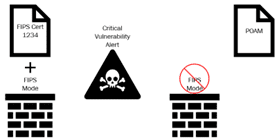CMMC - Temporary Deficiency Discussion
The Cybersecurity Maturity Model Certification (CMMC) 32 CFR Part 170 rule has been finalized and published on October 15, 2024. The rule does an excellent job at addressing contractor concerns over various issues. One of the most important changes is with the handling of deficiencies.
'Temporary Deficiency' Defined
The rule section defines a ‘temporary deficiency’ as “a condition where remediation of a discovered deficiency is feasible, and a known fix is available or is in process. The deficiency must be documented in an operational plan of action. A temporary deficiency is not based on an ‘in progress’ initial implementation of a CMMC security requirement but arises after implementation. A temporary deficiency may apply during the initial implementation of a security requirement if, during rollout, specific issues with a very limited subset of equipment is discovered that must be separately addressed. There is no standard duration for which a temporary deficiency may be active. For example, FIPS-validated cryptography that requires a patch and the patched version is no longer the validated version may be a temporary deficiency.”
FIPS-validated Cryptography
One such issue is practice SC.L2-3.13.11: Employ FIPS-validated cryptography when used to protect the confidentiality of CUI. The practice states, “determine if FIPS-validated cryptography is employed to protect the confidentiality of CUI.”
The SC.L2-3.13.11 Discussion paragraph states, “Cryptography can be employed to support many security solutions including the protection of controlled unclassified information, the provision of digital signatures, and the enforcement of information separation when authorized individuals have the necessary clearances for such information but lack the necessary formal access approvals. Cryptography can also be used to support random number generation and hash generation. Cryptographic standards include FIPS-validated cryptography and/or NSA-approved cryptography.”
Let’s take the following real-world example:
- You’ve retrieved the FIPS-validated certificate from the NIST CMVP site.
- You’ve enabled ‘FIPS Mode’ firmware on your next-generation firewall.
- You receive a critical vulnerability notification from the vendor & informs you to update to the latest firmware version to remediate the vulnerability.
- You update to the latest firmware & remediate the vulnerability, which invalidates your FIPS-validated cryptography.
- You would document this as a ‘temporary deficiency’ in your operational Plan of Action & continue to work with your vendor.

Recent Posts
- How Technology Is Transforming C3PAO Assessment Process
- Top Mistakes That Can Delay Your CMMC Assessment And How To Avoid Them
- The Hidden Value Of Professional CMMC Certification Services For DoD Contractors
- CMMC Compliance Made Practical: Strategies That Actually Work For Contractors
- How CMMC News Is Changing The Rules For Government Contractors
Search
Recent Comments
Recent Posts
- How Technology Is Transforming C3PAO Assessment Process October 15, 2025
- Top Mistakes That Can Delay Your CMMC Assessment And How To Avoid Them October 14, 2025
- The Hidden Value Of Professional CMMC Certification Services For DoD Contractors September 30, 2025
- CMMC Compliance Made Practical: Strategies That Actually Work For Contractors September 10, 2025
Archives
- October 2025 (2)
- September 2025 (4)
- August 2025 (2)
- July 2025 (6)
- June 2025 (8)
- April 2025 (9)
- March 2025 (5)
- February 2025 (1)
- January 2025 (8)
- December 2024 (7)
- October 2024 (2)
- March 2024 (1)
- February 2024 (1)
- January 2024 (1)
- December 2023 (1)
- August 2023 (1)
- July 2023 (1)
- June 2022 (1)
- April 2022 (1)
- November 2021 (1)
- June 2021 (1)
- May 2021 (1)

Recent Comments